Get free scan and check if your device is infected.
Remove it nowTo use full-featured product, you have to purchase a license for Combo Cleaner. Seven days free trial available. Combo Cleaner is owned and operated by RCS LT, the parent company of PCRisk.com.
What kind of application is BasicOperator?
Our analysis shows that BasicOperator is adware, and security vendors flag it as malicious. It can generate annoying and deceptive advertisements that may direct users to unsafe web pages. Thus, installing BasicOperator can expose users to various online threats. This app should not be trusted and should be uninstalled if present.
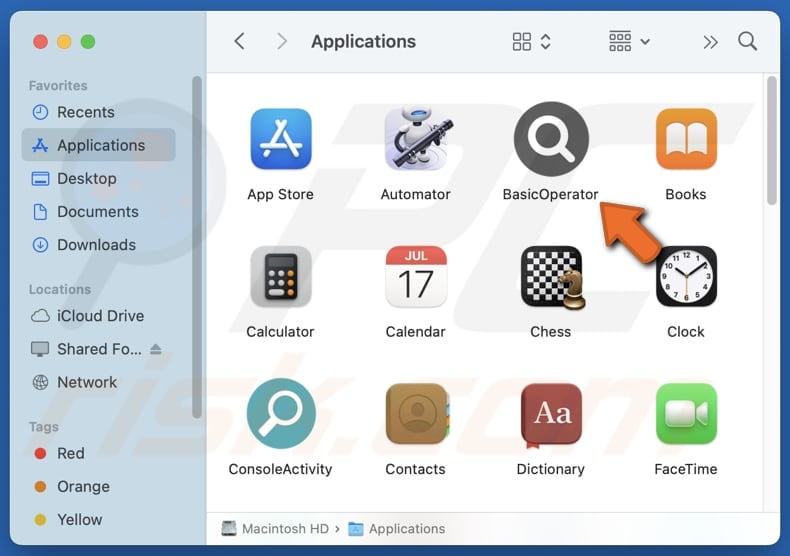
BasicOperator adware in detail
BasicOperator can bombard users with intrusive banners, coupons, pop-ups, and other advertisements that may urge users to "update software," promote bogus investment opportunities, contain fake social media messages, or contain other deceptive content. Interacting with these ads can direct users to untrustworthy websites.
For example, users may land on websites designed to steal credit card details, ID card information, login credentials, and other information. They may also encounter technical support scams crafted to extract money by offering fake services or products. Other sites may be used to deliver malware or gain remote access to computers.
Overall, interacting with ads from BasicOperator can lead users to unsafe websites, increasing the risk of identity theft, financial fraud, malware infections, and other security and privacy threats. Furthermore, BasicOperator may secretly gather personal data, such as browsing activity, names, and email addresses, which can then be shared with third parties (sold) and exploited.
Additionally, the app might be capable of modifying browser settings to direct users to questionable sites (e.g., fake search engines). For these reasons, users should avoid installing and uninstall it immediately if it is already installed. If manual removal cannot be achieved, a trusted security tool like Combo Cleaner can help to eliminate BasicOperator.
| Name | Ads by BasicOperator |
| Threat Type | Adware, Mac malware, Mac virus |
| Detection Names | Avast (MacOS:Adload-AG [Adw]), Combo Cleaner (Gen:Variant.Adware.MAC.AdLoad.13), ESET-NOD32 (A Variant Of OSX/Adware.Synataeb.G), Kaspersky (Not-a-virus:HEUR:AdWare.OSX.Adload.h), Full List (VirusTotal) |
| Additional Information | This application belongs to Adload malware family. |
| Symptoms | Your Mac becomes slower than normal, you see unwanted pop-up ads, you are redirected to dubious websites. |
| Distribution methods | Deceptive pop-up ads, free software installers (bundling), torrent file downloads. |
| Damage | Internet browser tracking (potential privacy issues), display of unwanted ads, redirects to dubious websites, loss of private information. |
| Malware Removal (Windows) |
To eliminate possible malware infections, scan your computer with legitimate antivirus software. Our security researchers recommend using Combo Cleaner. Download Combo CleanerTo use full-featured product, you have to purchase a license for Combo Cleaner. 7 days free trial available. Combo Cleaner is owned and operated by RCS LT, the parent company of PCRisk.com. |
Conclusion
It is common for adware to be promoted as legitimate software. However, it is a type of unwanted software that disrupts users by displaying intrusive ads. It can also slow down computers, modify browser settings, and lead to privacy and security risks. Thus, users should avoid installing it.
Other examples of adware include DynamicEntry, OverallVariety, and OperativeData.
How did BasicOperator install on my computer?
Adware is often bundled with free or untrustworthy software. Users who quickly install programs without reviewing options like "Advanced" or "Custom" (or unticking checkboxes) may unknowingly allow adware or other unwanted applications to be installed on computers (or injected into browsers).
Adware can also be installed through deceptive advertisements, fake software updates, misleading links on suspicious websites, shady browser notifications, unofficial app stores, peer-to-peer sharing networks, and third-party downloaders.
How to avoid installation of unwanted applications?
Before installing software, check user reviews and download only from official sources or reputable app stores. Use "Custom" or "Advanced" installation settings to decline unwanted extras. Keep your operating system and applications up to date to prevent security vulnerabilities. Block notifications from untrustworthy sites.
Avoid interacting with ads, pop-ups, or suspicious links from untrustworthy websites. Additionally, perform regular system scans with reputable security software and keep it up to date to ensure optimal protection. If your computer is already infected with BasicOperator, we recommend running a scan with Combo Cleaner Antivirus for Windows to automatically eliminate this adware.
The message that appears after the installation of BasicOperator:
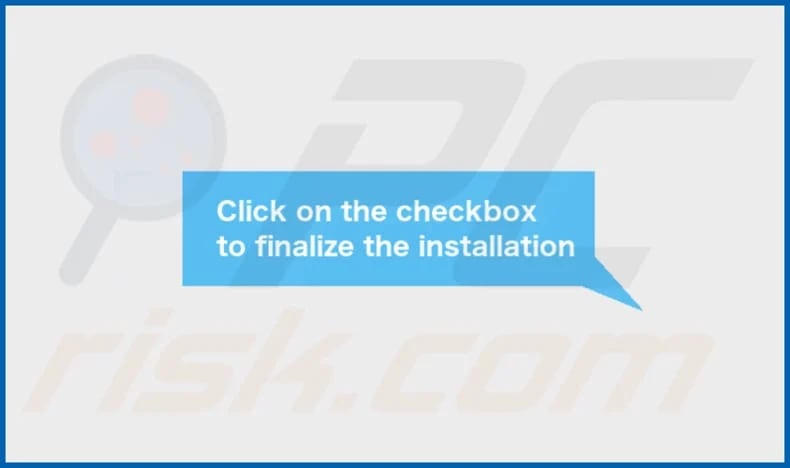
BasicOperator's installation folder:
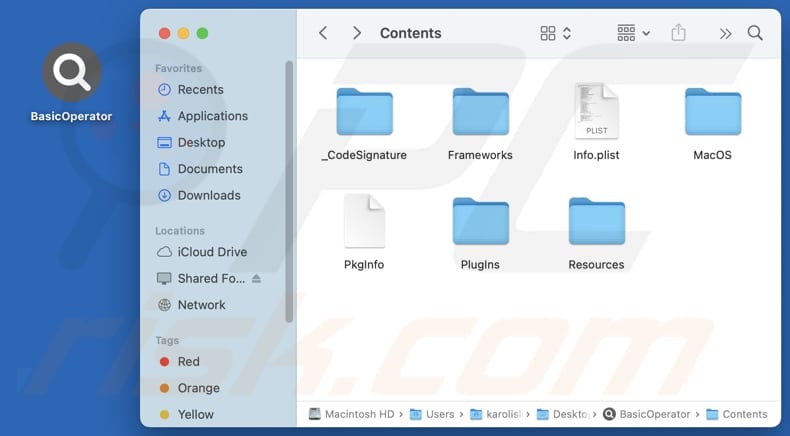
Instant automatic malware removal:
Manual threat removal might be a lengthy and complicated process that requires advanced IT skills. Combo Cleaner is a professional automatic malware removal tool that is recommended to get rid of malware. Download it by clicking the button below:
DOWNLOAD Combo CleanerBy downloading any software listed on this website you agree to our Privacy Policy and Terms of Use. To use full-featured product, you have to purchase a license for Combo Cleaner. 7 days free trial available. Combo Cleaner is owned and operated by RCS LT, the parent company of PCRisk.com.
Quick menu:
- What is BasicOperator?
- STEP 1. Remove BasicOperator related files and folders from OSX.
- STEP 2. Remove BasicOperator ads from Safari.
- STEP 3. Remove BasicOperator adware from Google Chrome.
- STEP 4. Remove BasicOperator ads from Mozilla Firefox.
Video showing how to remove adware and browser hijackers from a Mac computer:
BasicOperator adware removal:
Remove BasicOperator-related potentially unwanted applications from your "Applications" folder:
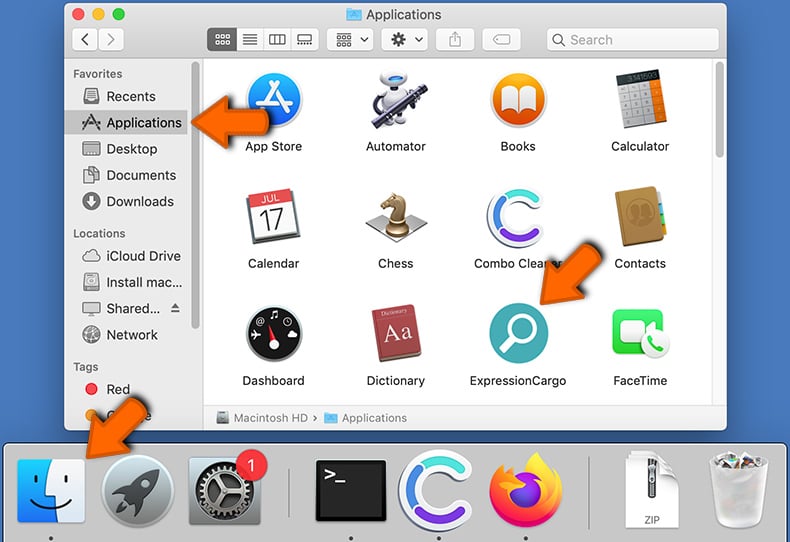
Click the Finder icon. In the Finder window, select "Applications". In the applications folder, look for "MPlayerX", "NicePlayer", or other suspicious applications and drag them to the Trash. After removing the potentially unwanted application(s) that cause online ads, scan your Mac for any remaining unwanted components.
DOWNLOAD remover for malware infections
Combo Cleaner checks if your computer is infected with malware. To use full-featured product, you have to purchase a license for Combo Cleaner. 7 days free trial available. Combo Cleaner is owned and operated by RCS LT, the parent company of PCRisk.com.
Remove adware-related files and folders
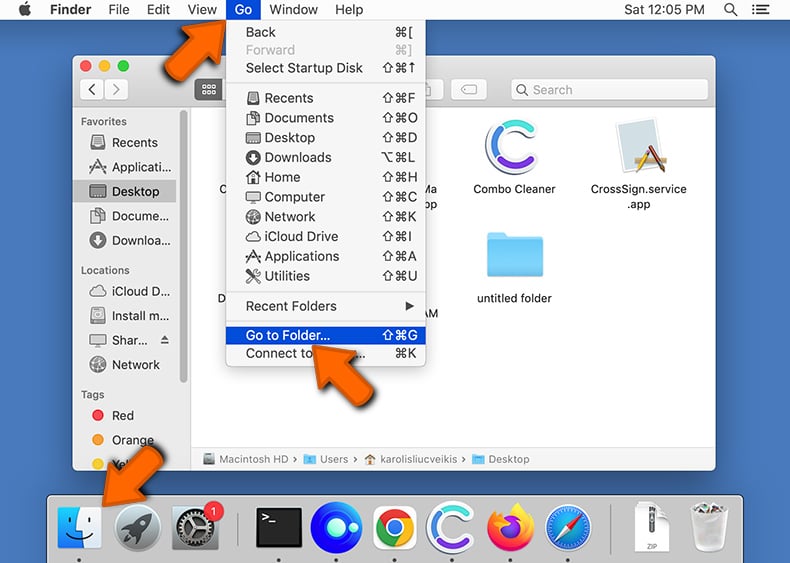
Click the Finder icon, from the menu bar. Choose Go, and click Go to Folder...
 Check for adware generated files in the /Library/LaunchAgents/ folder:
Check for adware generated files in the /Library/LaunchAgents/ folder:
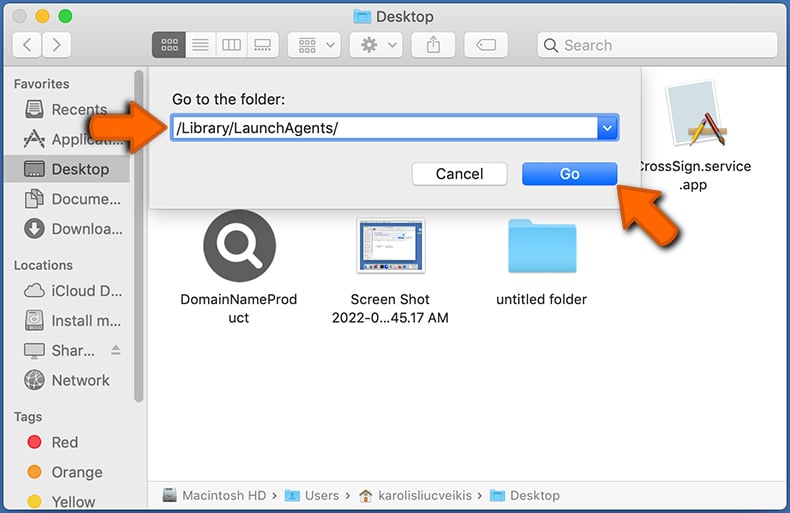
In the Go to Folder... bar, type: /Library/LaunchAgents/
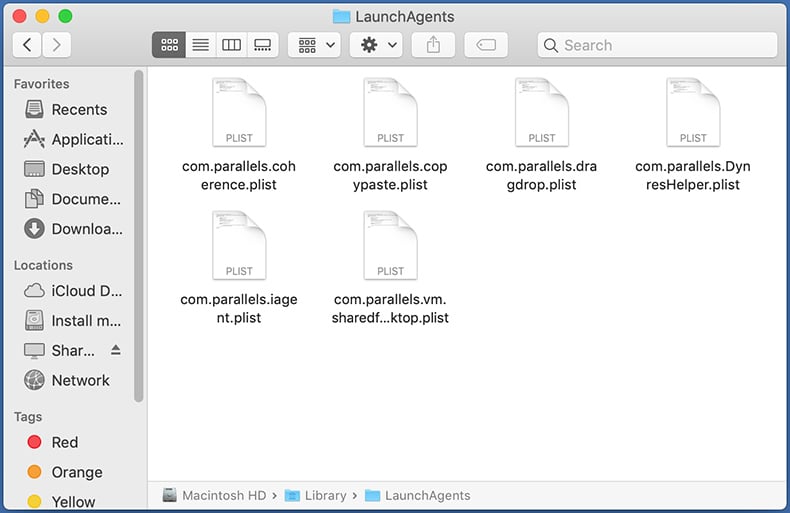
In the "LaunchAgents" folder, look for any recently-added suspicious files and move them to the Trash. Examples of files generated by adware - "installmac.AppRemoval.plist", "myppes.download.plist", "mykotlerino.ltvbit.plist", "kuklorest.update.plist", etc. Adware commonly installs several files with the exact same string.
 Check for adware generated files in the ~/Library/Application Support/ folder:
Check for adware generated files in the ~/Library/Application Support/ folder:
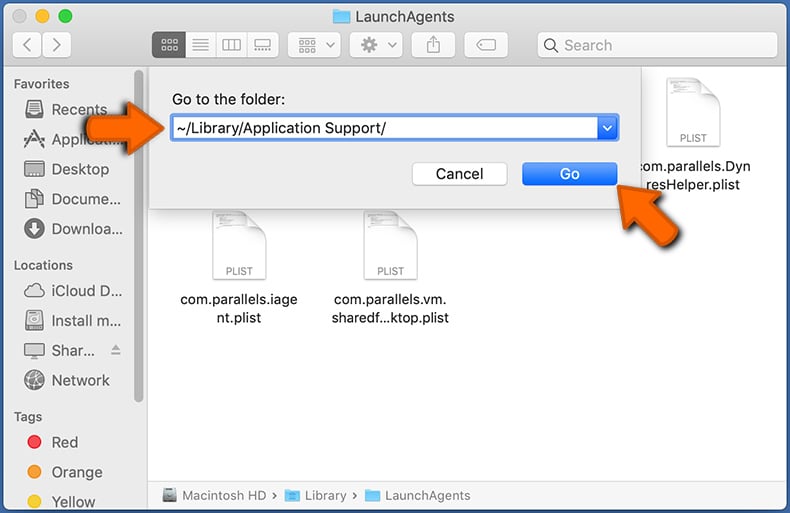
In the Go to Folder... bar, type: ~/Library/Application Support/
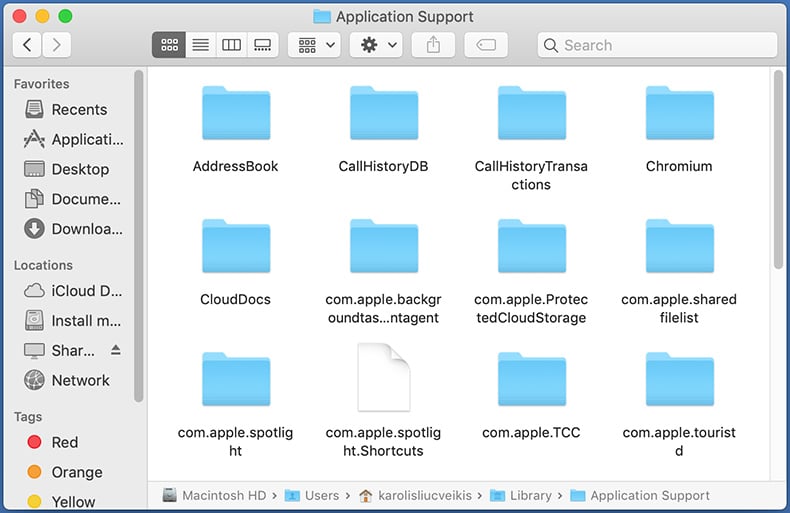
In the "Application Support" folder, look for any recently-added suspicious folders. For example, "MplayerX" or "NicePlayer", and move these folders to the Trash.
 Check for adware generated files in the ~/Library/LaunchAgents/ folder:
Check for adware generated files in the ~/Library/LaunchAgents/ folder:
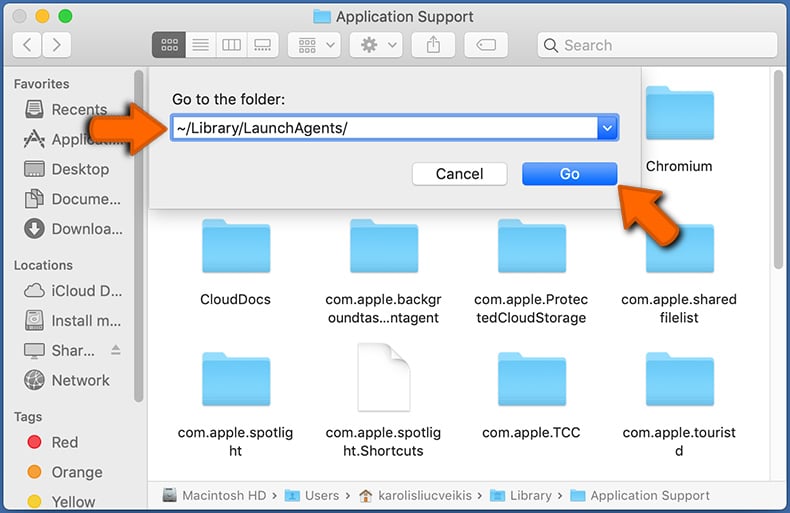
In the Go to Folder... bar, type: ~/Library/LaunchAgents/
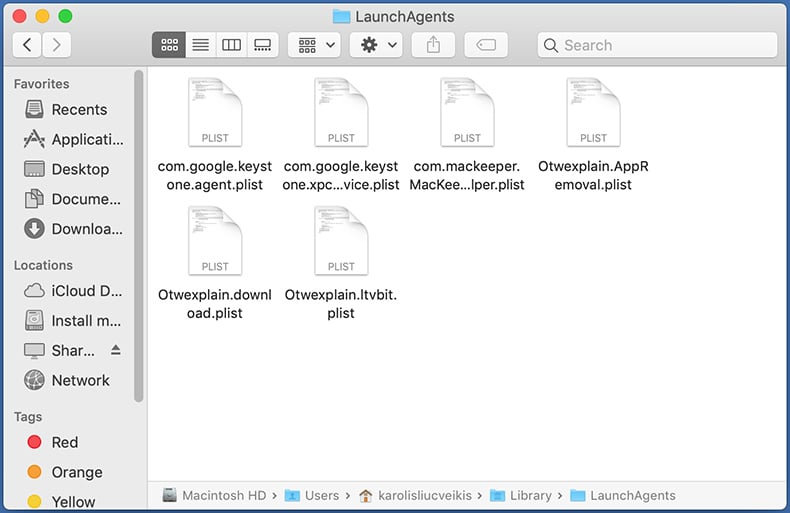
In the "LaunchAgents" folder, look for any recently-added suspicious files and move them to the Trash. Examples of files generated by adware - "installmac.AppRemoval.plist", "myppes.download.plist", "mykotlerino.ltvbit.plist", "kuklorest.update.plist", etc. Adware commonly installs several files with the exact same string.
 Check for adware generated files in the /Library/LaunchDaemons/ folder:
Check for adware generated files in the /Library/LaunchDaemons/ folder:
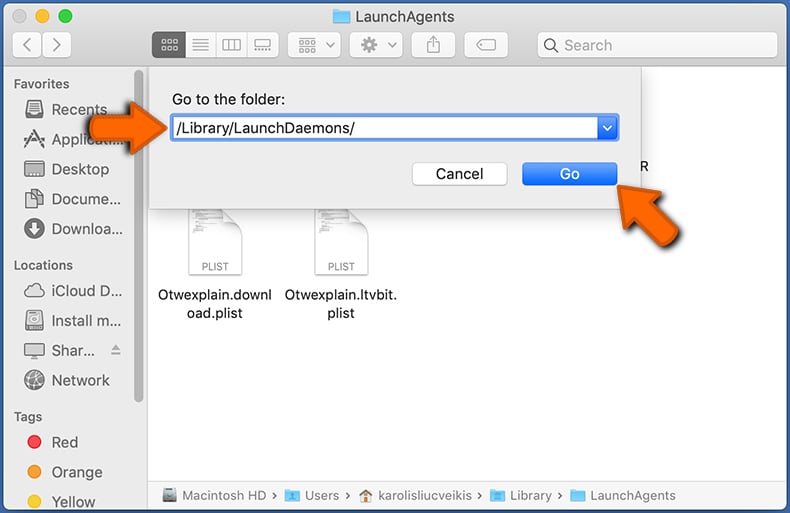
In the "Go to Folder..." bar, type: /Library/LaunchDaemons/
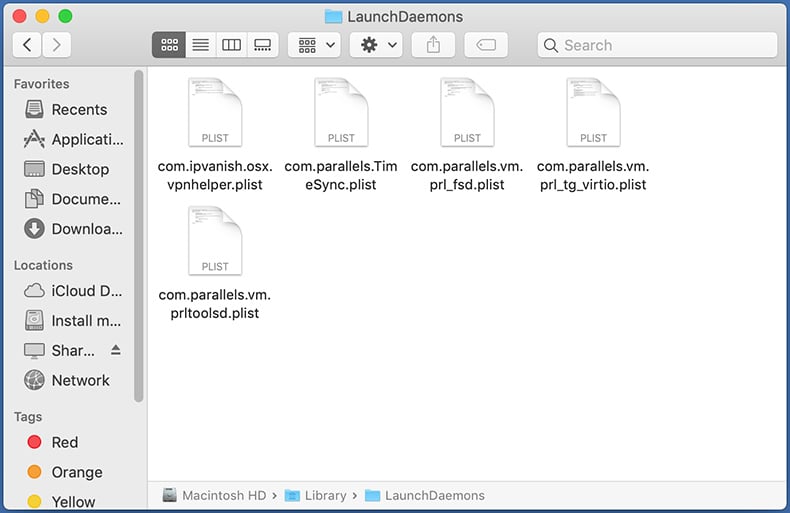
In the "LaunchDaemons" folder, look for recently-added suspicious files. For example "com.aoudad.net-preferences.plist", "com.myppes.net-preferences.plist", "com.kuklorest.net-preferences.plist", "com.avickUpd.plist", etc., and move them to the Trash.
 Scan your Mac with Combo Cleaner:
Scan your Mac with Combo Cleaner:
If you have followed all the steps correctly, your Mac should be clean of infections. To ensure your system is not infected, run a scan with Combo Cleaner Antivirus. Download it HERE. After downloading the file, double click combocleaner.dmg installer. In the opened window, drag and drop the Combo Cleaner icon on top of the Applications icon. Now open your launchpad and click on the Combo Cleaner icon. Wait until Combo Cleaner updates its virus definition database and click the "Start Combo Scan" button.
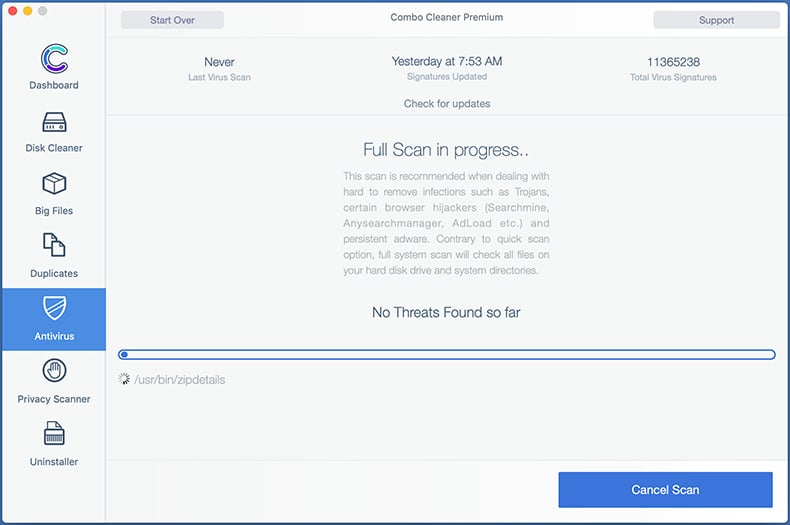
Combo Cleaner will scan your Mac for malware infections. If the antivirus scan displays "no threats found" - this means that you can continue with the removal guide; otherwise, it's recommended to remove any found infections before continuing.
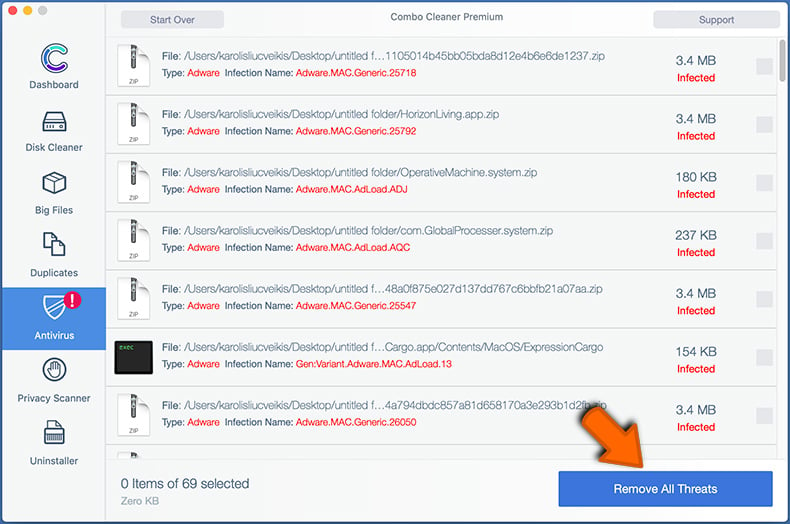
After removing files and folders generated by the adware, continue to remove rogue extensions from your Internet browsers.
Remove malicious extensions from Internet browsers
 Remove malicious Safari extensions:
Remove malicious Safari extensions:
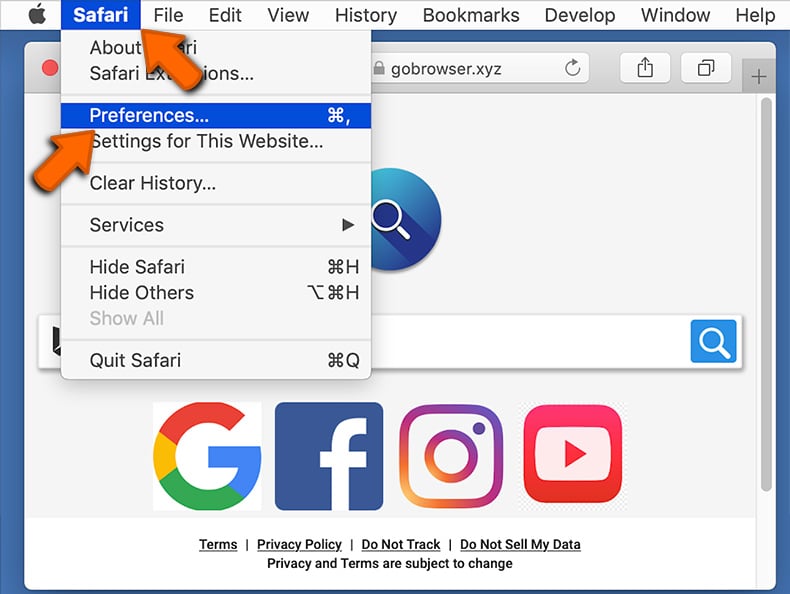
Open the Safari browser, from the menu bar, select "Safari" and click "Preferences...".
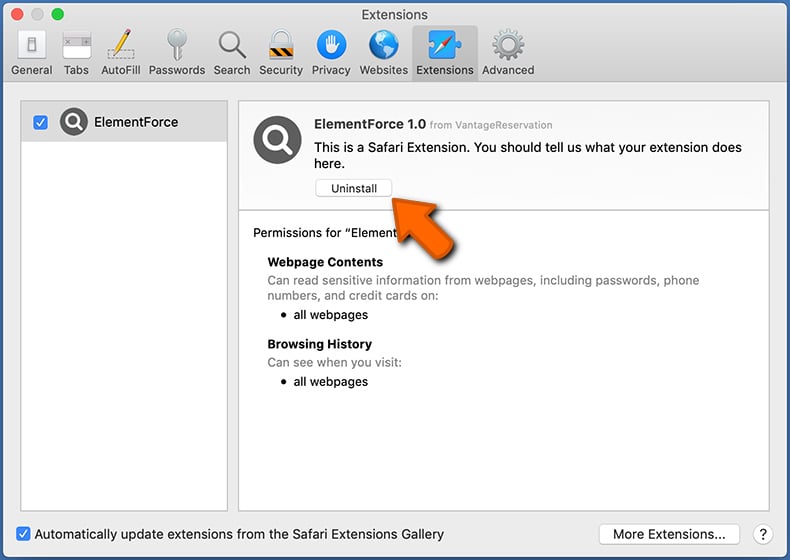
In the preferences window, select "Extensions" and look for any recently-installed suspicious extensions. When located, click the "Uninstall" button next to it/them. Note that you can safely uninstall all extensions from your Safari browser - none are crucial for regular browser operation.
- If you continue to have problems with browser redirects and unwanted advertisements - Reset Safari.
 Remove malicious extensions from Google Chrome:
Remove malicious extensions from Google Chrome:
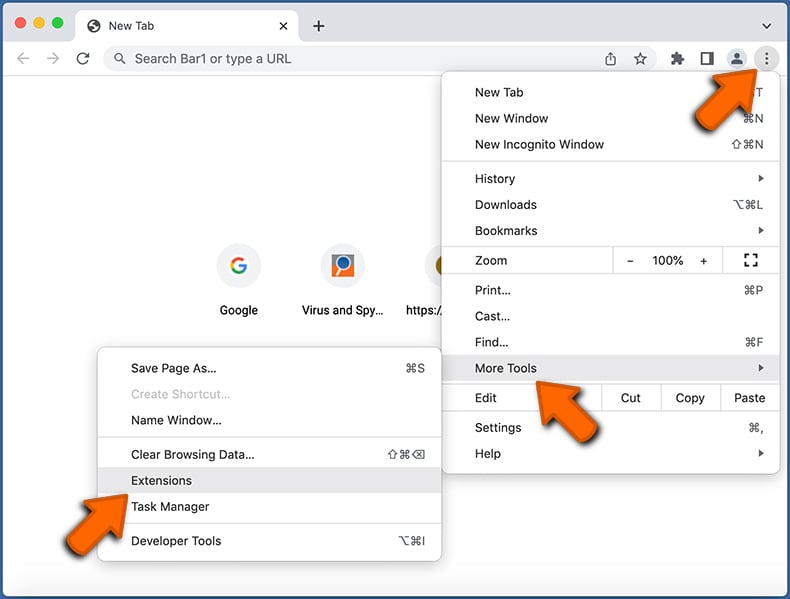
Click the Chrome menu icon ![]() (at the top right corner of Google Chrome), select "More Tools" and click "Extensions". Locate all recently-installed suspicious extensions, select these entries and click "Remove".
(at the top right corner of Google Chrome), select "More Tools" and click "Extensions". Locate all recently-installed suspicious extensions, select these entries and click "Remove".
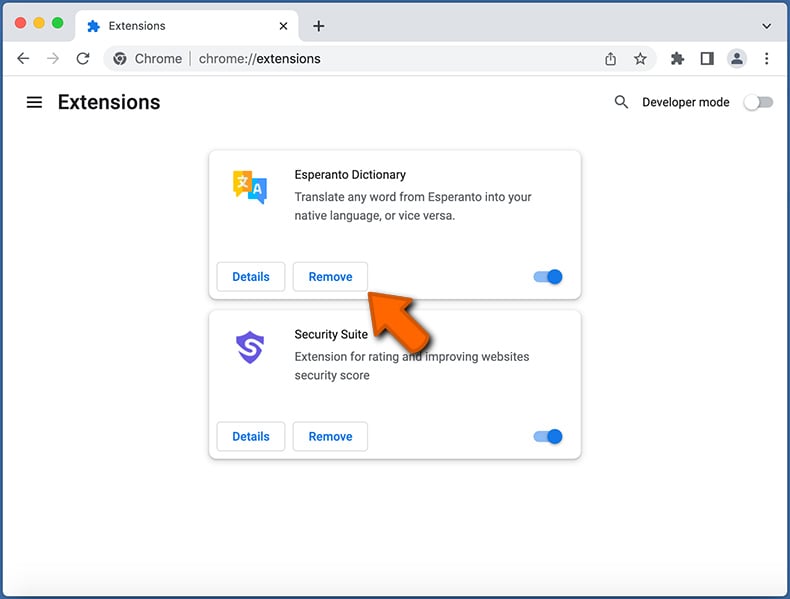
- If you continue to have problems with browser redirects and unwanted advertisements - Reset Google Chrome.
 Remove malicious extensions from Mozilla Firefox:
Remove malicious extensions from Mozilla Firefox:
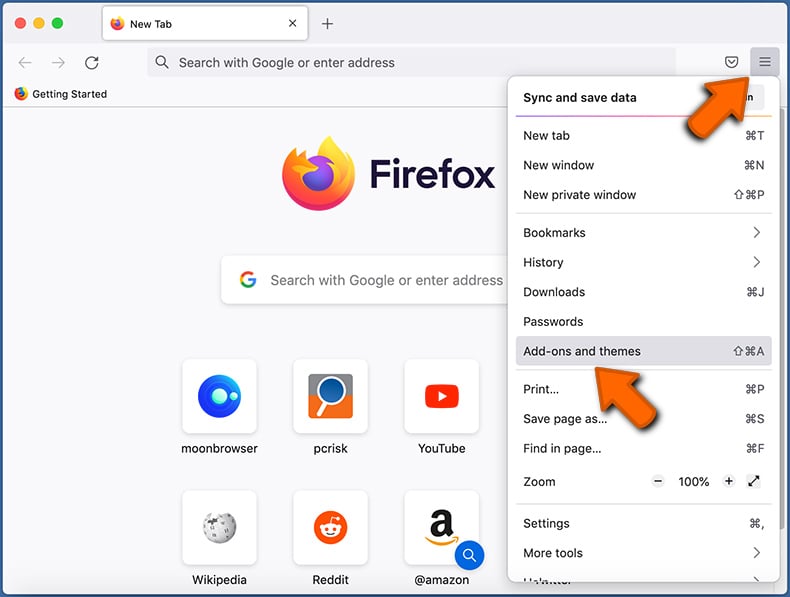
Click the Firefox menu ![]() (at the top right corner of the main window) and select "Add-ons and themes". Click "Extensions", in the opened window locate all recently-installed suspicious extensions, click on the three dots and then click "Remove".
(at the top right corner of the main window) and select "Add-ons and themes". Click "Extensions", in the opened window locate all recently-installed suspicious extensions, click on the three dots and then click "Remove".
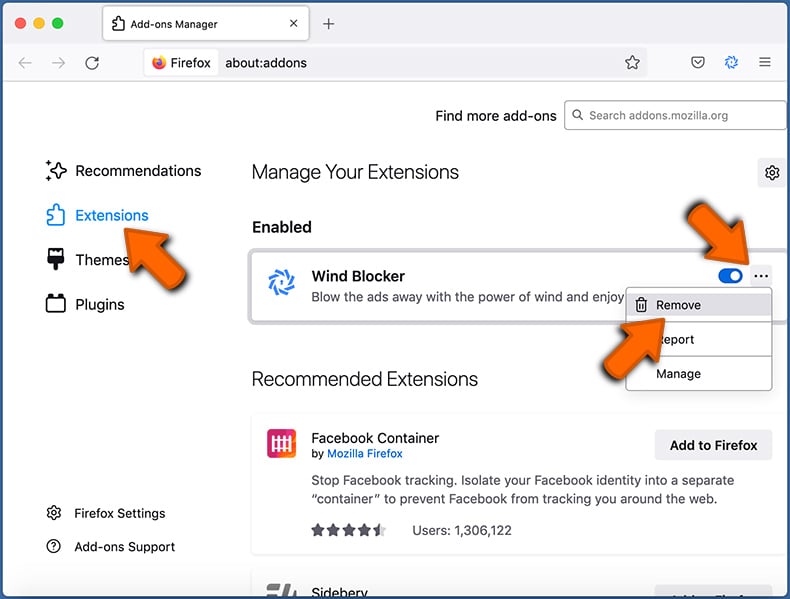
- If you continue to have problems with browser redirects and unwanted advertisements - Reset Mozilla Firefox.
Frequently Asked Questions (FAQ)
What harm can adware cause?
This software can disrupt browsing and overall user experience by causing unwanted and showing intrusive ads. It can also affect system performance and expose users to privacy and security risks.
What does adware do?
As a rule, the functionality of adware involves delivering ads. Additionally, adware can collect data and hijack browsers.
How do adware developers generate revenue?
Typically, adware developers earn money by displaying ads and promoting products or services through affiliate programs. They receive commissions when users interact with the ads, click on links, and (or) make purchases.
Will Combo Cleaner remove BasicOperator adware?
Combo Cleaner effectively detects and removes adware and other unwanted software. It offers a more thorough cleanup than manual methods, which may miss hidden files, ensuring that the system is completely cleaned. This makes it a reliable tool for protecting devices from malware and other threats.
Share:

Tomas Meskauskas
Expert security researcher, professional malware analyst
I am passionate about computer security and technology. I have an experience of over 10 years working in various companies related to computer technical issue solving and Internet security. I have been working as an author and editor for pcrisk.com since 2010. Follow me on Twitter and LinkedIn to stay informed about the latest online security threats.
PCrisk security portal is brought by a company RCS LT.
Joined forces of security researchers help educate computer users about the latest online security threats. More information about the company RCS LT.
Our malware removal guides are free. However, if you want to support us you can send us a donation.
DonatePCrisk security portal is brought by a company RCS LT.
Joined forces of security researchers help educate computer users about the latest online security threats. More information about the company RCS LT.
Our malware removal guides are free. However, if you want to support us you can send us a donation.
Donate
▼ Show Discussion